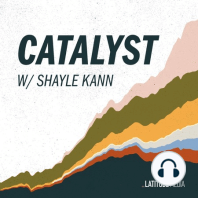51 min listen
Fixing cement’s carbon problem
ratings:
Length:
45 minutes
Released:
Nov 17, 2022
Format:
Podcast episode
Description
We want your feedback! Fill out our listener survey for a chance to win a $100 Patagonia gift card.
Join us on November 30 for a live, virtual episode of Climavores. Come ask a question about food, nutrition, and eating for the climate.
Concrete is an incredible material. It’s essentially pourable rock, and we use it in almost every part of the built world. We also consume more of it than any other man-made material in the world—about three tons per person annually.
And the secret ingredient in all this concrete? Cement. Think of it as the glue that binds the crushed rocks in concrete together.
But here’s the problem. Making cement emits lots of carbon. The cement industry alone produces 8% of global emissions.
Why? First, the process happens at 1500 degrees Celsius, a temperature so hot that companies often burn coal to reach it. Second, the chemical reaction involved in creating cement releases carbon dioxide.
So what are the solutions?
In this episode, Shayle talks to Leah Ellis, co-founder and CEO of Sublime Systems, a startup that has developed a novel way to produce cement at room temperature without releasing carbon dioxide. Shayle’s venture capital firm Energy Impact Partners is an investor in Sublime.
Shayle and Leah discuss:
The important properties of cement and why we use so much of it
The chemistry of cement and why it releases carbon dioxide
Alternative chemistries to Portland cement, the most common and useful formulation
Things you can add to the mix, called supplementary cementitious materials, to offset some of the Portland cement required (like fly ash from coal-fired power plants)
Adopting performance-based standards that allow more flexibility in the materials used in cement
Replacing coal with electrification and alternative fuels in cement kilns
Post-combustion carbon capture for cement kilns
CarbonCure’s technique for injecting carbon dioxide into concrete to increase strength and reduce the amount of cement required
Sublime System’s electrochemical technique for manufacturing cement without carbon emissions
Recommended Resources:
The New York Times: Making the Concrete and Steel We Need Doesn’t Have to Bake the Planet
Canary Media: Major construction firms team up to get the carbon out of concrete
Bloomberg: Breakthroughs Are Helping Even Cement and Steel Go Electric
E&E News: Congress wagered on ‘low-carbon’ concrete. Will it pay off?
Canary Media: Cement is terrible for the climate. California just passed a law to fix that
Catalyst is a co-production of Post Script Media and Canary Media.
Catalyst is supported by Scale Microgrid Solutions, your comprehensive source for all distributed energy financing. Distributed generation can be complex. Scale makes financing it easy. Visit scalecapitalsolutions.com to learn more.
Catalyst is supported by CohnReznick Capital, a trusted source for renewable energy investment banking servicing the US sustainability sector. Visit cohnreznickcapital.com to learn more.
Join us on November 30 for a live, virtual episode of Climavores. Come ask a question about food, nutrition, and eating for the climate.
Concrete is an incredible material. It’s essentially pourable rock, and we use it in almost every part of the built world. We also consume more of it than any other man-made material in the world—about three tons per person annually.
And the secret ingredient in all this concrete? Cement. Think of it as the glue that binds the crushed rocks in concrete together.
But here’s the problem. Making cement emits lots of carbon. The cement industry alone produces 8% of global emissions.
Why? First, the process happens at 1500 degrees Celsius, a temperature so hot that companies often burn coal to reach it. Second, the chemical reaction involved in creating cement releases carbon dioxide.
So what are the solutions?
In this episode, Shayle talks to Leah Ellis, co-founder and CEO of Sublime Systems, a startup that has developed a novel way to produce cement at room temperature without releasing carbon dioxide. Shayle’s venture capital firm Energy Impact Partners is an investor in Sublime.
Shayle and Leah discuss:
The important properties of cement and why we use so much of it
The chemistry of cement and why it releases carbon dioxide
Alternative chemistries to Portland cement, the most common and useful formulation
Things you can add to the mix, called supplementary cementitious materials, to offset some of the Portland cement required (like fly ash from coal-fired power plants)
Adopting performance-based standards that allow more flexibility in the materials used in cement
Replacing coal with electrification and alternative fuels in cement kilns
Post-combustion carbon capture for cement kilns
CarbonCure’s technique for injecting carbon dioxide into concrete to increase strength and reduce the amount of cement required
Sublime System’s electrochemical technique for manufacturing cement without carbon emissions
Recommended Resources:
The New York Times: Making the Concrete and Steel We Need Doesn’t Have to Bake the Planet
Canary Media: Major construction firms team up to get the carbon out of concrete
Bloomberg: Breakthroughs Are Helping Even Cement and Steel Go Electric
E&E News: Congress wagered on ‘low-carbon’ concrete. Will it pay off?
Canary Media: Cement is terrible for the climate. California just passed a law to fix that
Catalyst is a co-production of Post Script Media and Canary Media.
Catalyst is supported by Scale Microgrid Solutions, your comprehensive source for all distributed energy financing. Distributed generation can be complex. Scale makes financing it easy. Visit scalecapitalsolutions.com to learn more.
Catalyst is supported by CohnReznick Capital, a trusted source for renewable energy investment banking servicing the US sustainability sector. Visit cohnreznickcapital.com to learn more.
Released:
Nov 17, 2022
Format:
Podcast episode
Titles in the series (100)
Quantum computing could be a critical climate solution: The case for quantum computing as an enabler of climate tech. by Catalyst with Shayle Kann
